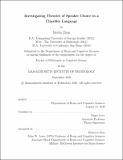Investigating theories of speaker choice in a classifier language
Author(s)
Zhan, Meilin,Ph. D.Massachusetts Institute of Technology.
Download1227512608-MIT.pdf (2.953Mb)
Other Contributors
Massachusetts Institute of Technology. Department of Brain and Cognitive Sciences.
Advisor
Roger Levy.
Terms of use
Metadata
Show full item recordAbstract
Speakers often face choices as to how to structure their intended message into an utterance. When multiple options are available to express more or less the same meaning, what general principles govern speaker choice? Here I investigate the influence of contextual predictability on the encoding of linguistic content manifested by speaker choice in a classifier language, Mandarin Chinese. In English, a numeral modifies a noun directly (e.g., three tables). In classifier languages such as Mandarin Chinese, it is obligatory to use a classifier (CL) with the numeral and the noun (e.g., three CL.flat table, three CL.general table). While different nouns are compatible with different specific classifiers, there is a general classifier "ge" (CL.general) that can be used with most nouns. I focus on the alternating options between using the general classifier versus a specific classifier with the same noun where the options are nearly semantically invariant. When the upcoming noun has high surprisal, the use of a specific classifier would reduce surprisal at the noun thus potentially facilitate comprehension (predicted by the Uniform Information Density account (Levy & Jaeger, 2007)), but the use of that specific classifier may be dispreferred from a production standpoint if accessing the general classifier requires less effort (predicted by the Availability-Based Production account (Bock, 1987; Ferreira & Dell, 2000)). Using evidence from naturalistic language datasets and real-time language production experiments, I have argued that speaker choice is emerged from availability-based production and is the results of speaker-centric information processing, where availability is affected by linguistic experience such as contextual predictability and word frequency, as well as real-time production pressure in speaking. From the perspective of language design, the redundancy in information content shared between nouns and classifiers provides a mechanism that potentially is beneficial for the listener, making communication more robust. However, the capacity of using a specific classifier is constrained by speaker-oriented availability production.
Description
Thesis: Ph. D., Massachusetts Institute of Technology, Department of Brain and Cognitive Sciences, May, 2020 Cataloged from student-submitted PDF version of thesis. Includes bibliographical references (pages 117-125).
Date issued
2020Department
Massachusetts Institute of Technology. Department of Brain and Cognitive SciencesPublisher
Massachusetts Institute of Technology
Keywords
Brain and Cognitive Sciences.